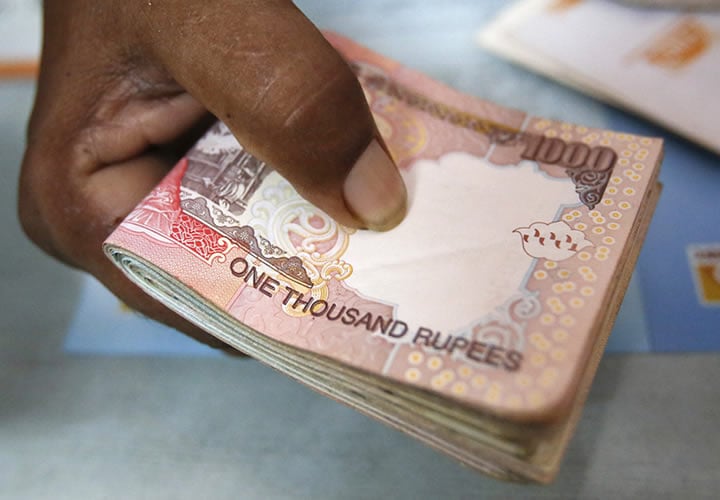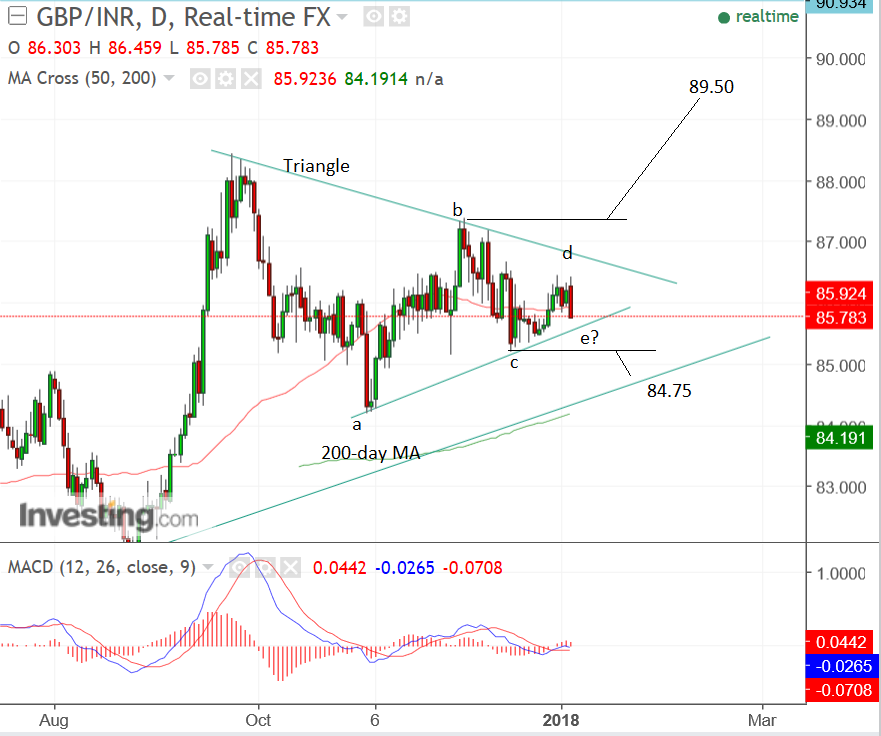The Pound-to-Rupee Exchange Rate: Waiting for Volatility

The exchange rate of the Pound-to-Rupee currency pair is trading in ever narrower ranges as the market waits for a definitive signal to reprice the currency either higher or lower, yet complex themes frustrate.
The Pound-to-Rupee exchange rate has traded within an increasingly narrow range and the outlook for the pair remains uncertain.
The daily chart shows the formation of a symmetrical triangle which indicates a breakout is likely to happen soon, although it cannot specify the direction.

There is a slight bias to a break higher given the trend prior to the formation of the triangle was up and so is more likely than not to break higher, however, the bias is marginal at best and doesn't form the basis for a recommendation.
The triangle looks almost finished, having probably formed four constituent waves, labeled a-d; triangles normally have a minimum of five waves and less often more than five.
Once wave 'e' has completed the exchange rate will probably breakout, with the conformation of a breakout higher coming from a move above the b-wave highs at 87.40 and an upside target at 89.50.
Alternatively, a breakout to the downside would gain confirmation from a move below c-wave lows at 85.20 and then probably fall to an initial target at 84.75 at the level of a trendline.
Macroeconomic Themes
Fundamental views of the Rupee are mixed, mirroring the lack of directionality in the charts.
One major source of Rupee strength has been foreign investors buying Indian bonds.
"The rupee had risen almost 6 per cent against the US dollar in 2017, buoyed by strong inflows into Indian capital markets."
"The Indian debt segment had witnessed an inflow of about $23 billion last year, the second best from the data available since 2002," Gurumurthy K of The Hindu Business Line.
But the outlook for the bond market is not particularly positive at the moment following the news that corporate bond interest rates rose to 16-year highs after the government said it was going on a borrowing spree, which will flood debt markets with government bonds in 2018.
Yet such concerns may be offset by forecasts that the Reserve Bank of India (RBI) will raise interest rates more times in 2018 than previously thought amidst a surge in inflationary pressures.
"Goldman Sachs Group Inc. expects the Reserve Bank of India to lift rates three times by mid-2019 while the market is pricing in only about one increase this year as shown by local swap rates as inflationary pressures build in Asia's No. 3 economy and growth recovers from a cash ban and the introduction of a unified goods and services tax," says Divya Patil of the Economic Times.
“We expect the strength in rupee to continue in the first half of 2018. But, depreciation pressure can emerge in the second half of the year as the global bond yields are expected to trend higher," says Sajal Gupta, Head of Forex and Rates at Edelweiss Securities Ltd.
Another concern is rising oil prices as commodities start the new year in fine fetal.
"Domestically, rising oil prices and the widening current account deficit (CAD) could pose a minor challenge for the rupee,” says Soumyajit Niyogi, Associate Director of Core Analytical Group, India Ratings and Research (as printed in The Hindu Business Line).
“If oil prices go up from here and flows in the capital account do not improve, it could bring pressure on the balance of payment (BoP) front which in turn can weaken the rupee," cautions Niyogi.
Get up to 5% more foreign exchange by using a specialist provider by getting closer to the real market rate and avoid the gaping spreads charged by your bank for international payments. Learn more here.
